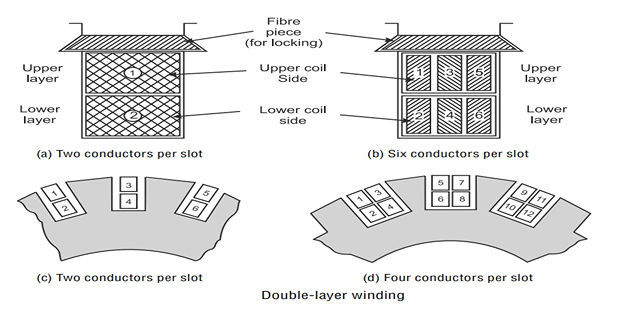Demonstrative Video
Armature Winding
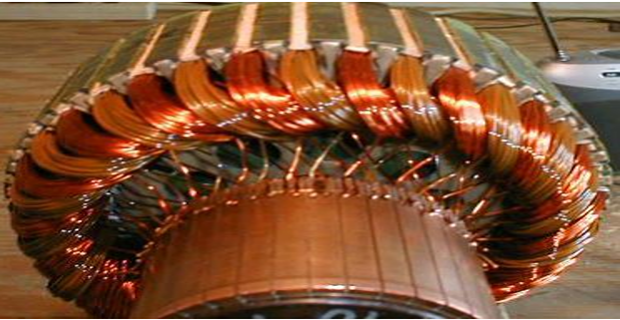
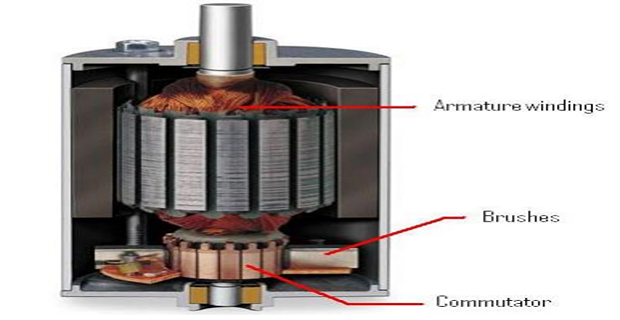
At the outer periphery of an armature core, slots are cut.
In these slots number of conductors are placed which are connected with each other in proper arrangement forming series–parallel paths depending upon the requirement.
This arrangement of connections is known as armature winding.
To understand the armature winding schemes, it is desirable to have an idea about the following terms.
Conductor:The length of wire embedded in armature core and lying within the magnetic field is called the conductor
It may be having one or more parallel strands.
Total number of conductors in the armature winding are represented by the symbol Z.
Turn: Two conductors lying in a magnetic field connected in series at the back, so that emf induced in them is additive is known as a turn.
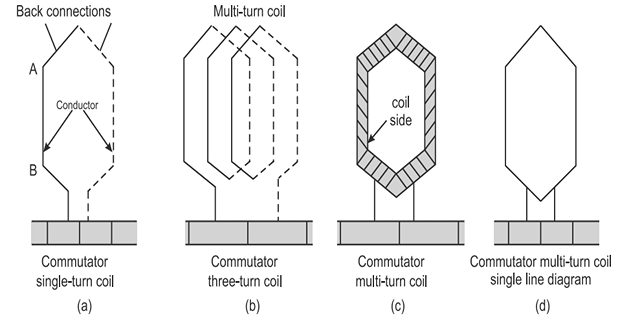
Coil: A coil may be a single turn coil having only two conductors, or it may be a multi-turn coil having more than two conductors , a three-turn coil is shown.
The bunch of three conductors may be wrapped by the cotton tape, before placing in the slot of armature.
A multi-turn coil can be represented by single line diagram.
Multi-turn coils are used to develop higher voltages.
When the armature conductors are more, it is not feasible to use single turn coils because it will require large number of commutator segments and if used it will not give spark-less commutation.
Moreover, it will not be economical due to use of more copper in the end connections.
The total number of coils in the armature winding are represented by symbol ‘C’.
Coil side: Each coil (single turn or multi-turn) has two sides called coil sides.
Both the coil sides are embedded in two different slots as per the winding design (nearly a pole pitch apart).
Coil group: A group of coils may have one or more coils.
Winding: When number of coil groups are arranged on the armature in a particular fashion as per the design, it is called an armature winding.
Inductance effect: All the coils have some inductance effect as current is changing in them.
Due to inductance effect the flow of current is opposed causing reduction in resultant output voltage.
Over-hanging end connections have some adverse effect due to inductance.
Front-end and Back-end connectors: A wire that is used to connect end of a coil at the front to the commutator segment is called a front-end connector.
Whereas, a wire that is used to connect one coil side to the other coil side at the back is called back-end connector.
Pole pitch: defined as number of armature slots per pole.
It may also be defined as the number of armature conductors per pole.
If there are 36 conductors for 4 poles then pole pitch will be equal to 36/4 i.e., 9 conductors per pole.
Back pitch: The distance in terms of number of armature conductors between first and last conductor of the same coil i.e., the distance between two coil sides of the same coil is called back pitch.
It is also called the coil span or coil spread and is denoted by \(Y_b\).
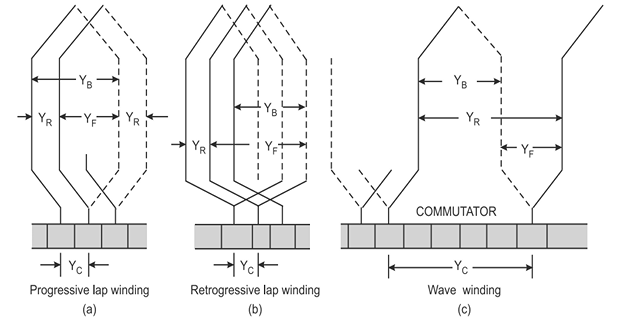
Front pitch: The distance in terms of number of armature conductors or number of slots between second conductor of one coil and the first conductor of the next coil which are connected to the same commutator segment on the front is called front pitch, denoted by \(Y_F\).
Resultant pitch: The distance in terms of number of armature conductors or number of slots between the start of one coil and the start of the next coil to which it is connected is called resultant pitch, denoted by \(Y_R\)
Commutator pitch: The distance measured in terms of commutator segments between the segments to which the two ends of a coil are connected is called commutator pitch, denoted by \(Y_C\).
Coil span or coil pitch: The distance in terms of number of armature conductors or number of slots between two sides of the same coil is called coil span or coil pitch.
The coil span may be equal to, less than or more than pole pitch.
Accordingly, the coils are knows as full pitched, short pitched or over pitched coils respectively.
For instance, where pole pitch is say 4. One side of coil-A is placed is slot No. 1 and the other side is placed in slot No. 5, then the coil span is 5-1 = 4 which is equal to pole pitch hence coil-A is called a full-pitched coil.
Whereas, in case of coil-B, the coil span is 6–3 = 3 which is less than pole pitch, this coil is called a short pitched coil.
When the coils are full pitched, the induced emf in a coil is the arithmetic sum of the emfs induced in two sides of the same coil since the coil sides are displaced by 180° electrical.
Two sides of the same coil are placed at similar position of two adjacent poles (North and South).
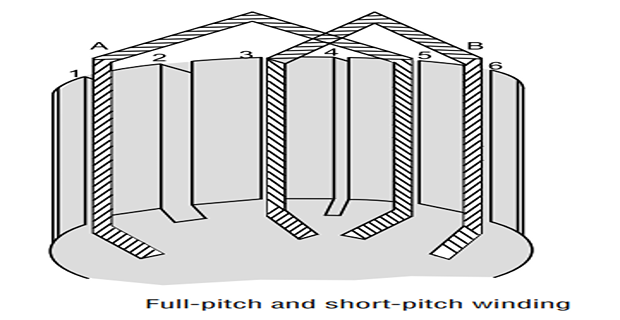
In case of short pitched and over pitched coils, the resultant induced emf is reduced because the two sides would fall under the influence of the same pole at some instant.
At this instance the induced emf in the two sides will oppose each other causing reduction in resultant emf (phasor difference).
The advantage of short pitched winding is that in this case the copper used for end connections is reduced substantially which reduces the cost of machine.
It also improves the commutation (reduction of sparking at brushes) because inductance of overhang connections is reduced.
Moreover, it reduces the copper losses and improves the efficiency to some extent.
Hence, many a times short pitched winding is used.
Degree of Re-entrant of an armature winding: There can be single re-entrant or multi reentrant armature winding.
While tracing through a winding once, if all armature conductors are included on returning to the starting point, the winding is called single re-entrant winding.
It will be double re-entrant if only half of the conductors are included in tracing through the winding once.
Types of Armature Winding
The continuous or closed armature windings are of two types:
Gramme-ring winding
Drum Winding
The gramme-ring type of armature winding is an early form of armature winding.
This winding is replaced by more efficient drum type winding.
Disadvantages of gramme-ring type armature winding
Only half the coil was available to link with the pole flux.
The other half of the portion of winding was lying inside the core which was used only as connectors and so there was wastage of copper.
As each turn was to pass through the centre of the core, therefore, it was difficult to wind and require more labour, hence was costlier.
The maintenance and repairs were more costly.
Insulation of winding was also difficult.
For the same pole flux and armature velocity the emf induced in ring winding was half of that induced in the drum winding having same number of coils.
Construction was having a large air gap, so stronger field excitation was required to produce the required flux.
Drum Winding
Conductors are housed in slots cut over the armature surface and connected to one another at the front and back through connectors.
Whole of the copper used is active except end connectors, i.e., it cuts flux and, therefore, is active in generating emf.
The coils can be pre-formed and insulated before placing on the armature, which reduces the construction cost.
The drum winding may be either single layer or double layer winding.
In single layer winding, only one conductor or one coil side is placed in each armature slot. It is rarely used because of its more cost.
In two-layer winding, there are two conductors or coil sides per slot arranged in two layers. Mostly it is employed because of economy reasons.
These coils are usually are wound on machine driven formers which give them proper shape.
The turns may be bound together with cotton tape.
The ends are left bare to solder them to the commutator segments.
The coils are then dipped into some insulating compound such as asphalt and are then dried.
If the machine is to be operated at high temperatures, other materials, such as mica and paper tape, fibre glass tape, and silicon impregnated insulation may be used.
Before placing the coils in the slots, liners of leatheroid are placed to ensure mechanical protection is provided to the coils.
After dropping the coils into the slots, wedges of wood or hard fibre are driven to hold them in place.
To obtain maximum voltage a full pitched winding is used.
However, the span may be reduced to as much as eight-tenth of the pole pitch without any serious reduction in the induced emf.
When this is done, the winding is called short pitch (or fractional pitch) winding.
Usually, one side of every coil lies in the top of one slot and the other side lies in the bottom of some other slot at a distance of approximately one pole pitch along the armature.
Thus, at least two coil sides occupy each slot.
Such windings, in which two coil sides occupy each slot are most commonly used for all medium sized machines.
In case of large machines, more coil-sides can be placed in a single slot.
Placing of several elements in a single slot gives fewer slots than segments which have got following advantages.
By providing more conductors in one slot, the number of slots decreases. As the number of slots is reduced the armature core teeth become mechanically stronger to bear the stresses.
Number of commutator segments is increased, the voltage between segments adjacent to each other decreases and the number of turns of wire in the coils connected to adjacent segments also decreases. The result is that there is less sparking at the commutator because of the improved commutation.
The overall cost of construction is reduced.
In general there are two types of drum type armature windings:
lap winding
wave windings.
